Fine-Scale Quantification of the Effect of Maize Tassel on Canopy Reflectance with 3D Radiative Transfer Modeling
Abstract
1. Introduction
2. Materials and Methods
2.1. Study Area and Experimental Designs
2.2. Canopy Reflectance Observation
2.3. 3D Structure Reconstruction of Maize
2.4. Spectral Measurement of Maize Tassel
2.5. LESS Model Simulated Canopy Reflectance
3. Results
3.1. Consistency Analysis of Canopy Simulation and Measured Spectrum
3.2. Differences in the Effects of Different Tassels on Canopy Reflectance
3.2.1. Tassel Structure
3.2.2. Tassel Spectrum
3.3. The Effect of Tassel on Canopy Reflectance in Different 3D Scenes
3.3.1. Different Planting Density
3.3.2. Different Leaf Area Index
3.4. Directional Effect of Tassel on Canopy Reflectance in Maize
3.4.1. Main Directional Features of the Canopy without Tassels
3.4.2. Directional Distribution of Canopy Reflectance Difference
4. Discussion
4.1. The Change in Tassel Influence under the Difference of Canopy Characteristics
4.2. The Anisotropic Characteristics of Tassel Affecting Canopy Reflectance
4.3. The Influence Mechanism of Maize Tassel on Canopy Reflectance
4.4. Limitations of Quantifying Tassel Effects on Canopy Reflectance
5. Conclusions
Author Contributions
Funding
Data Availability Statement
Conflicts of Interest
References
- van der Velde, M.; d’Andrimont, R.; Taymans, M.; Lemoine, G.; Ceglar, A.; Yordanov, M. Detecting flowering phenology in oil seed rape parcels with Sentinel-1 and-2 time series. Remote. Sens. Environ. 2020, 239, 111660. [Google Scholar] [CrossRef]
- Guo, Y.; Fu, Y.H.; Chen, S.; Bryant, C.R.; Li, X.; Senthilnath, J.; Sun, H.; Wang, S.; Wu, Z.; de Beurs, K. Integrating spectral and textural information for identifying the tasseling date of summer maize using UAV based RGB images. Int. J. Appl. Earth Obs. Geoinf. 2021, 102, 102435. [Google Scholar] [CrossRef]
- Liaqat, W.; Akmal, M.; Ali, J. Sowing dates effect on production of high yielding maize varieties. Sarhad J. Agric. 2018, 34, 102–113. [Google Scholar] [CrossRef]
- Rudnick, D.R.; Irmak, S.; Djaman, K.; Sharma, V. Impact of irrigation and nitrogen fertilizer rate on soil water trends and maize evapotranspiration during the vegetative and reproductive periods. Agric. Water Manag. 2017, 191, 77–84. [Google Scholar] [CrossRef]
- Butler, E.E.; Huybers, P. Variations in the sensitivity of us maize yield to extreme temperatures by region and growth phase. Environ. Res. Lett. 2015, 10, 034009. [Google Scholar] [CrossRef]
- Capristo, P.R.; Rizzalli, R.H.; Andrade, F.H. Ecophysiological yield components of maize hybrids with contrasting maturity. Agron. J. 2007, 99, 1111–1118. [Google Scholar] [CrossRef]
- Grassini, P.; Yang, H.; Cassman, K.G. Limits to maize productivity in western corn-belt: A simulation analysis for fully irrigated and rainfed conditions. Agric. For. Meteorol. 2009, 149, 1254–1265. [Google Scholar] [CrossRef]
- Tollenaar, M.; Ahmadzadeh, A.; Lee, E.A. Physiological basis of heterosis for grain yield in maize. Crop Sci. 2004, 44, 2086–2094. [Google Scholar] [CrossRef]
- McBratney, A.; Whelan, B.; Ancev, T.; Bouma, J. Future directions of precision agriculture. Precis. Agric. 2005, 6, 7–23. [Google Scholar] [CrossRef]
- Shao, M.; Nie, C.; Zhang, A.; Shi, L.; Zha, Y.; Xu, H.; Yang, H.; Yu, X.; Bai, Y.; Liu, S. Quantifying effect of maize tassels on LAI estimation based on multispectral imagery and machine learning methods. Comput. Electron. Agric. 2023, 211, 108029. [Google Scholar] [CrossRef]
- Li, W.; Jiang, J.; Weiss, M.; Madec, S.; Tison, F.; Philippe, B.; Comar, A.; Baret, F. Impact of the reproductive organs on crop BRDF as observed from a UAV. Remote Sens. Environ. 2021, 259, 112433. [Google Scholar] [CrossRef]
- Li, B.; Junhua, B.; Qing, X.; Qinhuo, L.; Ze, Z.; Xin, L.; Linghua, M. Effects of maize tassel at the heading stage on radiation transfer characteristics of canopy reflectance. Trans. Chin. Soc. Agric. Eng. 2019, 35, 162–170. [Google Scholar]
- Zhao, X.; Qi, J.; Xu, H.; Yu, Z.; Yuan, L.; Chen, Y.; Huang, H. Evaluating the potential of airborne hyperspectral LiDAR for assessing forest insects and diseases with 3D radiative transfer modeling. Remote Sens. Environ. 2023, 297, 113759. [Google Scholar] [CrossRef]
- Dash, J.P.; Watt, M.S.; Pearse, G.D.; Heaphy, M.; Dungey, H.S. Assessing very high resolution uav imagery for monitoring forest health during a simulated disease outbreak. ISPRS J. Photogramm. Remote Sens. 2017, 131, 1–14. [Google Scholar] [CrossRef]
- Gastellu-Etchegorry, J.P.; Martin, E.; Gascon, F. DART: A 3D model for simulating satellite images and studying surface radiation budget. Int. J. Remote Sens. 2004, 25, 73–96. [Google Scholar] [CrossRef]
- Qi, J.; Xie, D.; Yin, T.; Yan, G.; Gastellu-Etchegorry, J.-P.; Li, L.; Zhang, W.; Mu, X.; Norford, L.K. LESS: Large-scale remote sensing data and image simulation framework over heterogeneous 3D scenes. Remote Sens. Environ. 2019, 221, 695–706. [Google Scholar] [CrossRef]
- Huang, H.; Qin, W.; Liu, Q. RAPID: A radiosity applicable to porous individual objects for directional reflectance over complex vegetated scenes. Remote Sens. Environ. 2013, 132, 221–237. [Google Scholar] [CrossRef]
- Bechtold, S.; Höfle, B. Helios: A multi-purpose lidar simulation framework for research, planning and training of laser scanning operations with airborne, ground-based mobile and stationary platforms. ISPRS Ann. Photogramm. Remote Sens. Spat. Inf. Sci. 2016, 3, 161–168. [Google Scholar] [CrossRef]
- Qi, J.; Xie, D.; Xu, Y.; Yan, G. Principles and applications of the 3D radiative transfer model LESS. Remote Sens. Technol. Appl. 2019, 34, 914–924. [Google Scholar]
- Jiang, J.; Weiss, M.; Liu, S.; Baret, F. Effective GAI is best estimated from reflectance observations as compared to GAI and LAI: Demonstration for wheat and maize crops based on 3D radiative transfer simulations. Field Crop. Res. 2022, 283, 108538. [Google Scholar] [CrossRef]
- Jiang, J.; Weiss, M.; Liu, S.; Rochdi, N.; Baret, F. Speeding up 3D radiative transfer simulations: A physically based metamodel of canopy reflectance dependency on wavelength, leaf biochemical composition and soil reflectance. Remote Sens. Environ. 2020, 237, 111614. [Google Scholar] [CrossRef]
- Xu, B.; Wan, X.; Yang, H.; Feng, H.; Fu, Y.; Cen, H.; Wang, B.; Zhang, Z.; Li, S.; Zhao, C. TIPS: A three-dimensional phenotypic measurement system for individual maize tassel based on TreeQSM. Comput. Electron. Agric. 2023, 212, 108150. [Google Scholar] [CrossRef]
- Widlowski, J.-L.; Mio, C.; Disney, M.; Adams, J.; Andredakis, I.; Atzberger, C.; Brennan, J.; Busetto, L.; Chelle, M.; Ceccherini, G. The fourth phase of the radiative transfer model intercomparison (RAMI) exercise: Actual canopy scenarios and conformity testing. Remote Sens. Environ. 2015, 169, 418–437. [Google Scholar] [CrossRef]
- Li, W.; Yan, G.; Mu, X.; Tong, Y.; Zhou, K.; Xie, D. Modeling the hotspot effect for vegetation canopies based on path length distribution. Remote Sens. Environ. 2024, 303, 113985. [Google Scholar] [CrossRef]
- Zhao, X.; Qi, J.; Yu, Z.; Yuan, L.; Huang, H. Fine-scale quantification of absorbed photosynthetically active radiation (APAR) in plantation forests with 3D radiative transfer modeling and LiDAR data. Plant Phenom. 2024, 6, 0166. [Google Scholar] [CrossRef] [PubMed]
- Kuester, T.; Spengler, D. Structural and spectral analysis of cereal canopy reflectance and reflectance anisotropy. Remote Sens. 2018, 10, 1767. [Google Scholar] [CrossRef]
- Li, Y.; Gao, J.; Zha, Y. Impact of rice canopy structure on canopy reflectance spectra. In Proceedings of the Remote Sensing and Space Technology for Multidisciplinary Research and Applications, SPIE, Beijing, China, 19–24 May 2005; Volume 6199, pp. 113–122. [Google Scholar]
- Shibayama, M.; Wiegand, C.L. View azimuth and zenith, and solar angle effects on wheat canopy reflectance. Remote Sens. Environ. 1985, 18, 91–103. [Google Scholar] [CrossRef]
- Huang, H.; Liu, Q.; Qin, W. Thermal emission hot-spot effect of crop canopies—Part I: Simulation. IEEE J. Sel. Top. Appl. Earth Obs. Remote Sens. 2010, 3, 313–322. [Google Scholar] [CrossRef]
- Middleton, E.M. Solar zenith angle effects on vegetation indices in tallgrass prairie. Remote Sens. Environ. 1991, 38, 45–62. [Google Scholar] [CrossRef]
- Huang, W.; Wang, Z.; Huang, L.; Lamb, D.W.; Ma, Z.; Zhang, J.; Wang, J.; Zhao, C. Estimation of vertical distribution of chlorophyll concentration by bi-directional canopy reflectance spectra in winter wheat. Precis. Agric. 2011, 12, 165–178. [Google Scholar] [CrossRef]
- Ollinger, S.V. Sources of variability in canopy reflectance and the convergent properties of plants. New Phytol. 2011, 189, 375–394. [Google Scholar] [CrossRef] [PubMed]
- Gutierrez, M.; Reynolds, M.P.; Klatt, A.R. Effect of leaf and spike morphological traits on the relationship between spectral reflectance indices and yield in wheat. Int. J. Remote Sens. 2015, 36, 701–718. [Google Scholar] [CrossRef]

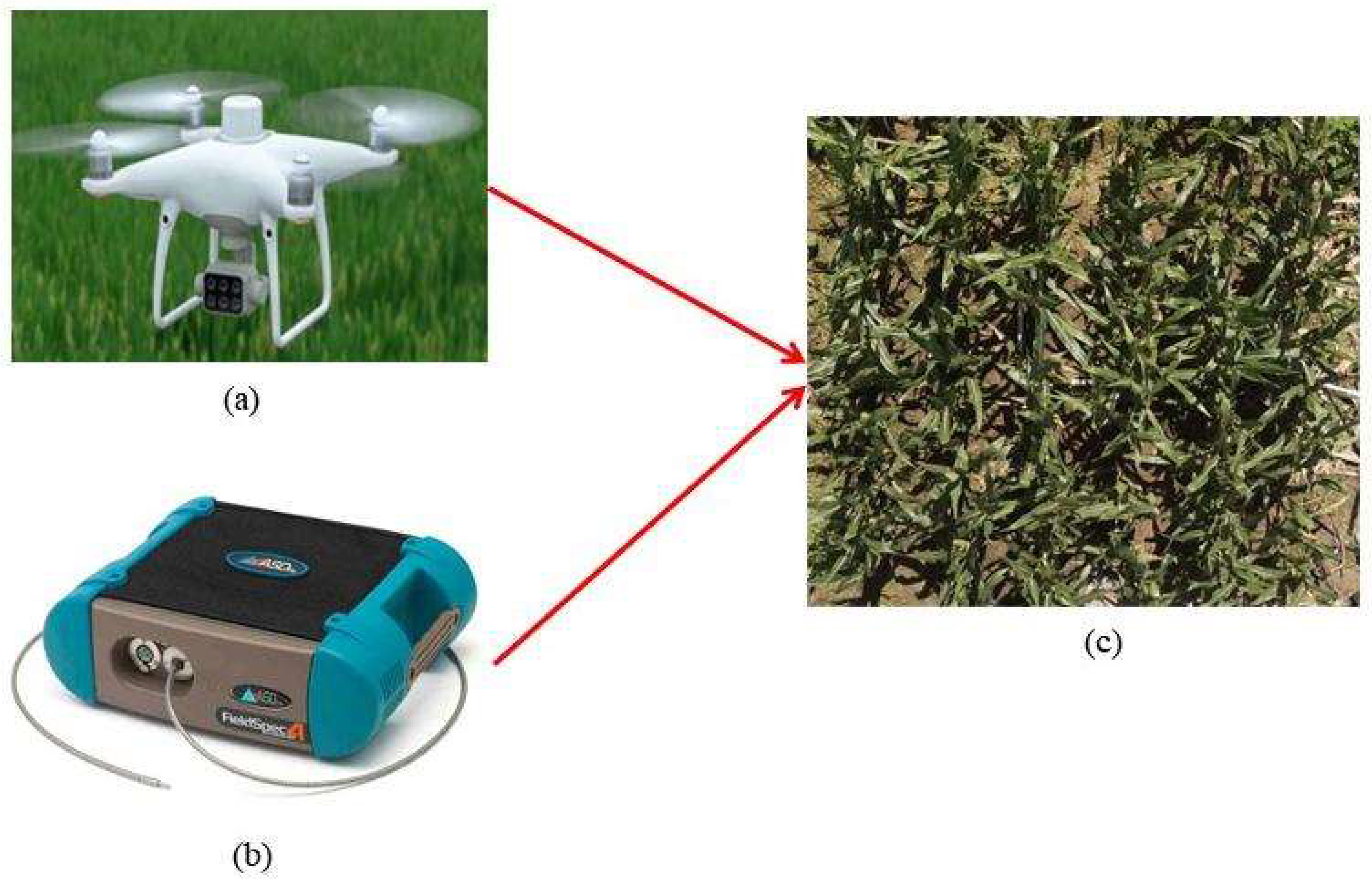
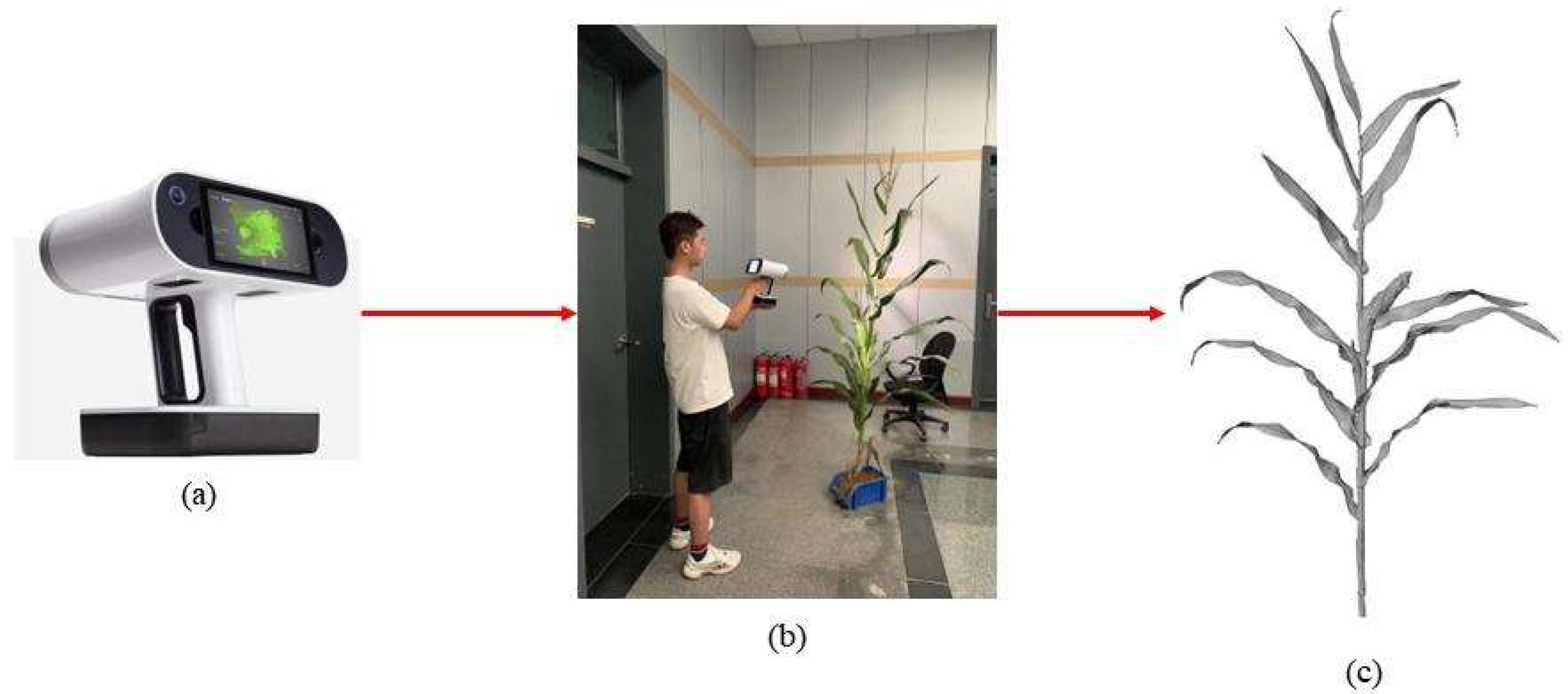
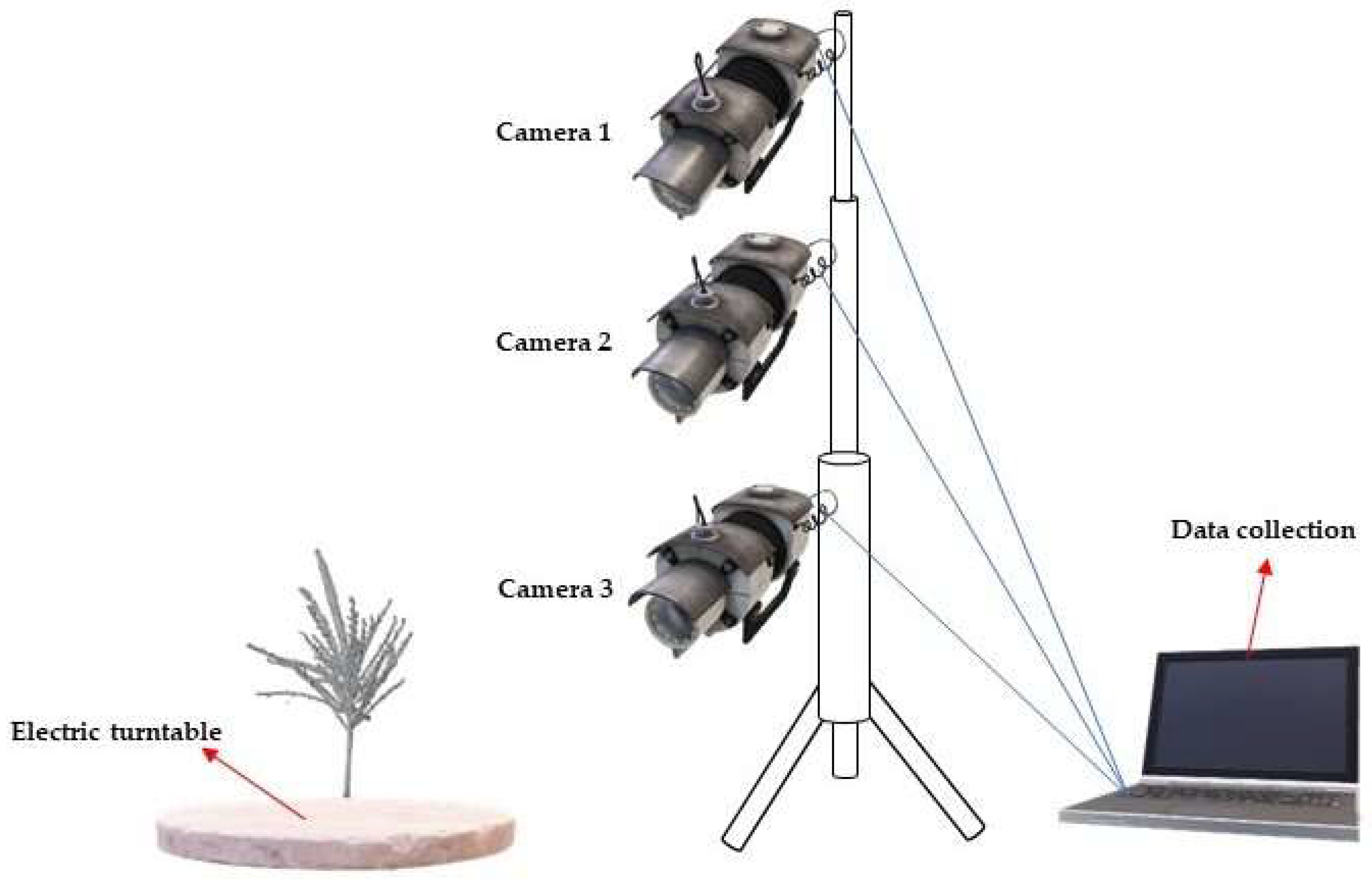
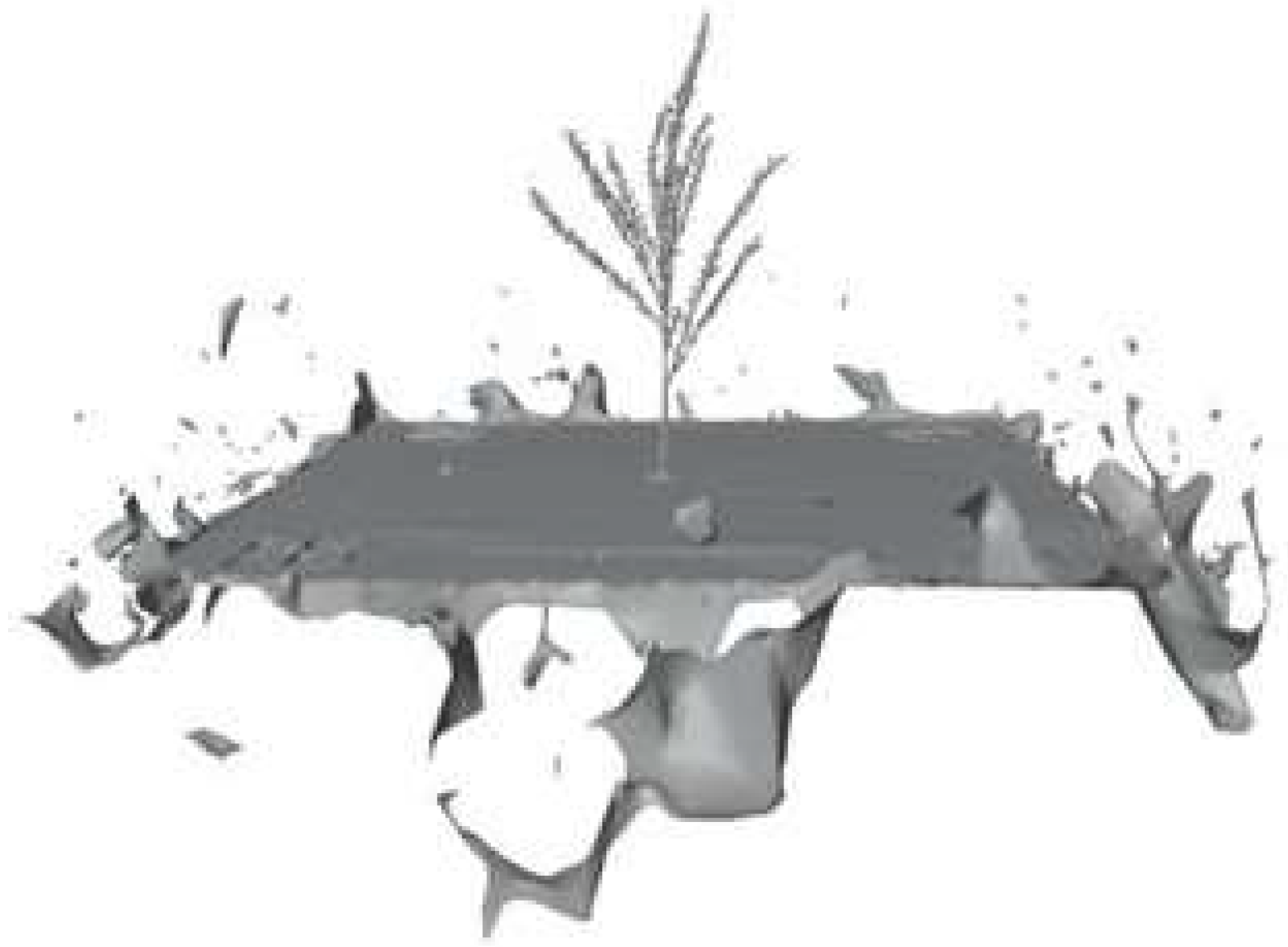


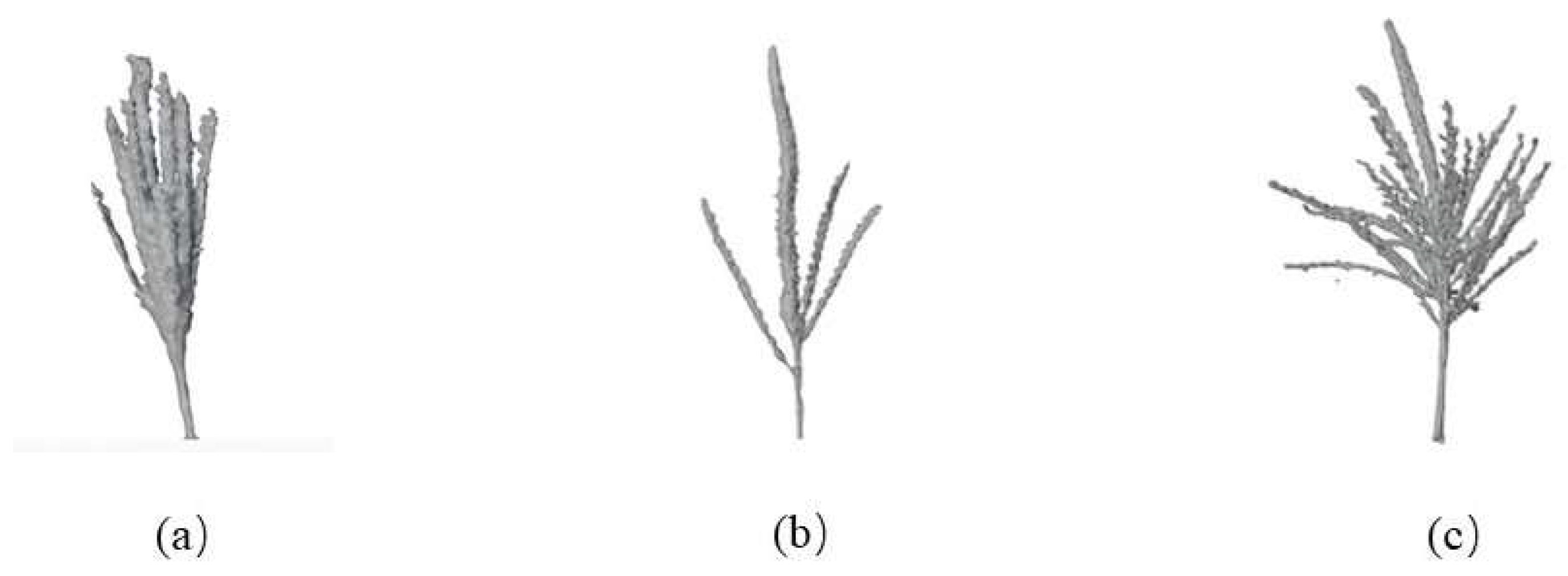

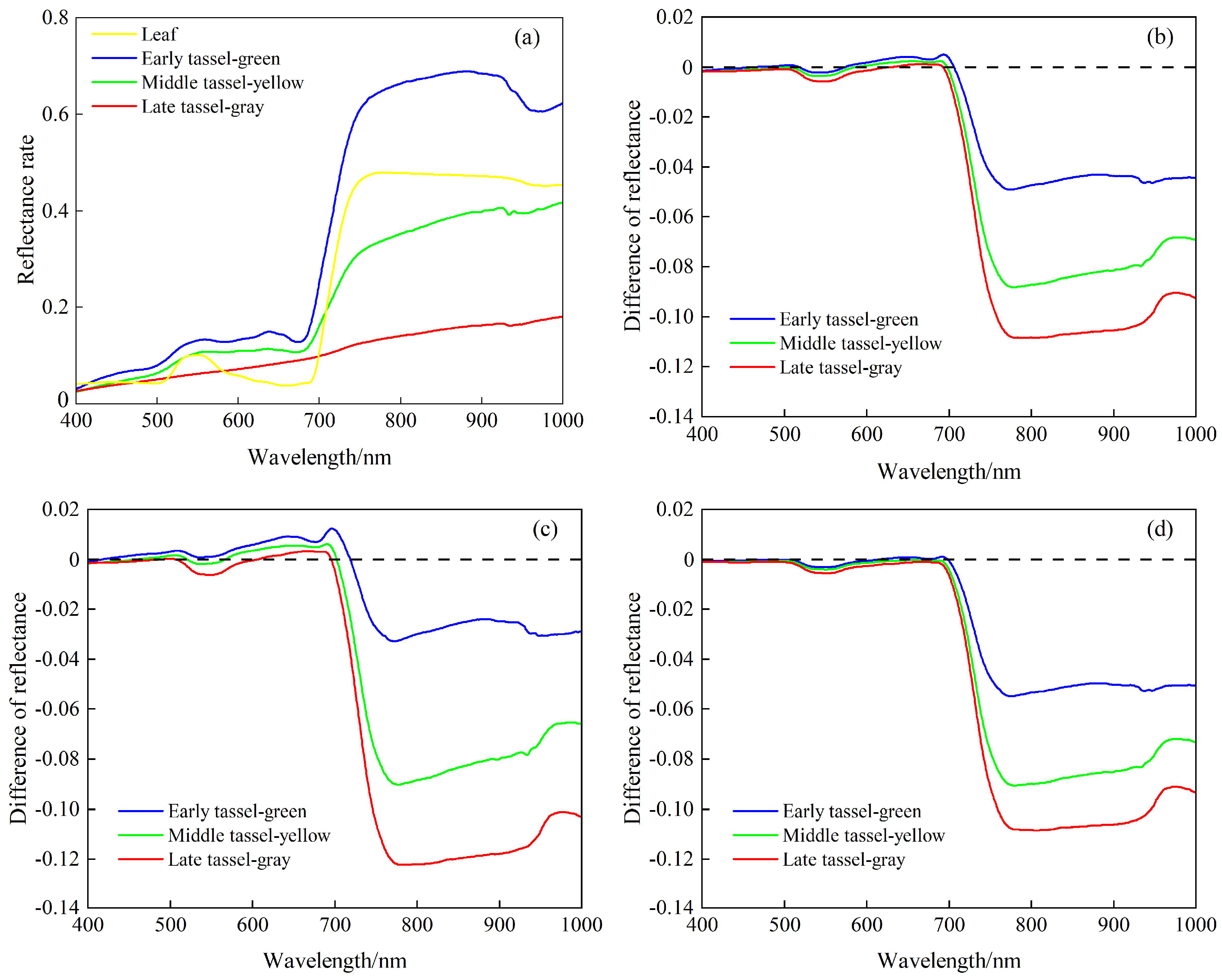




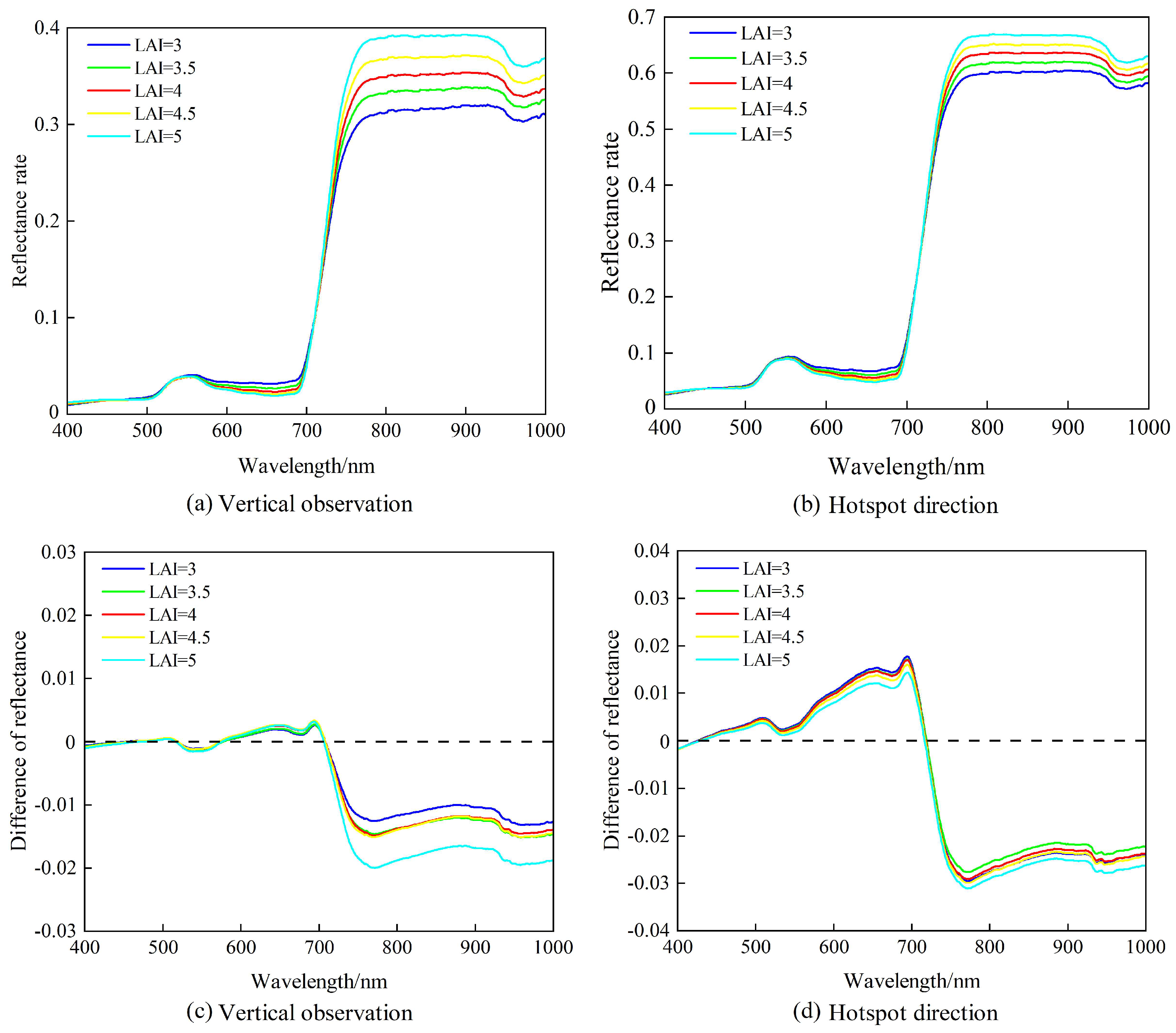

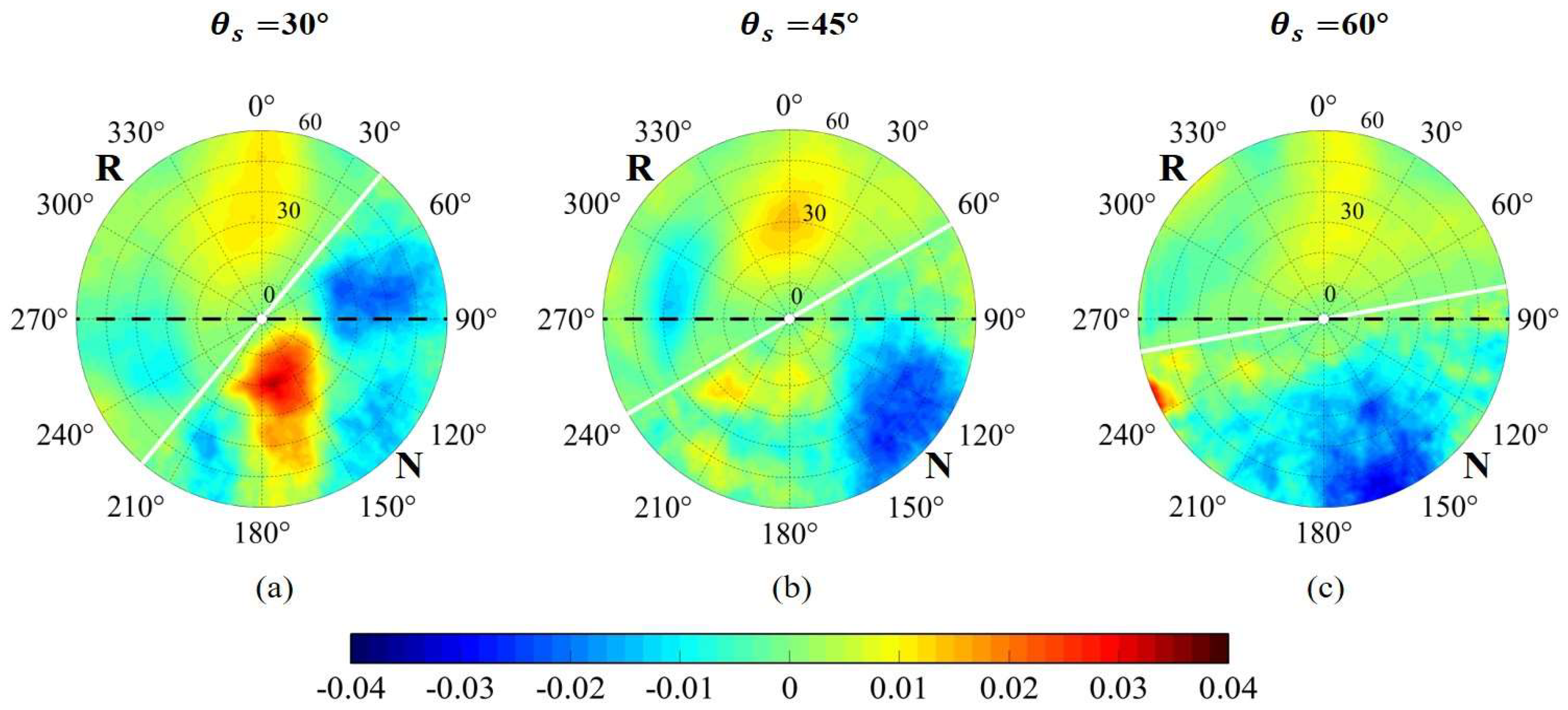
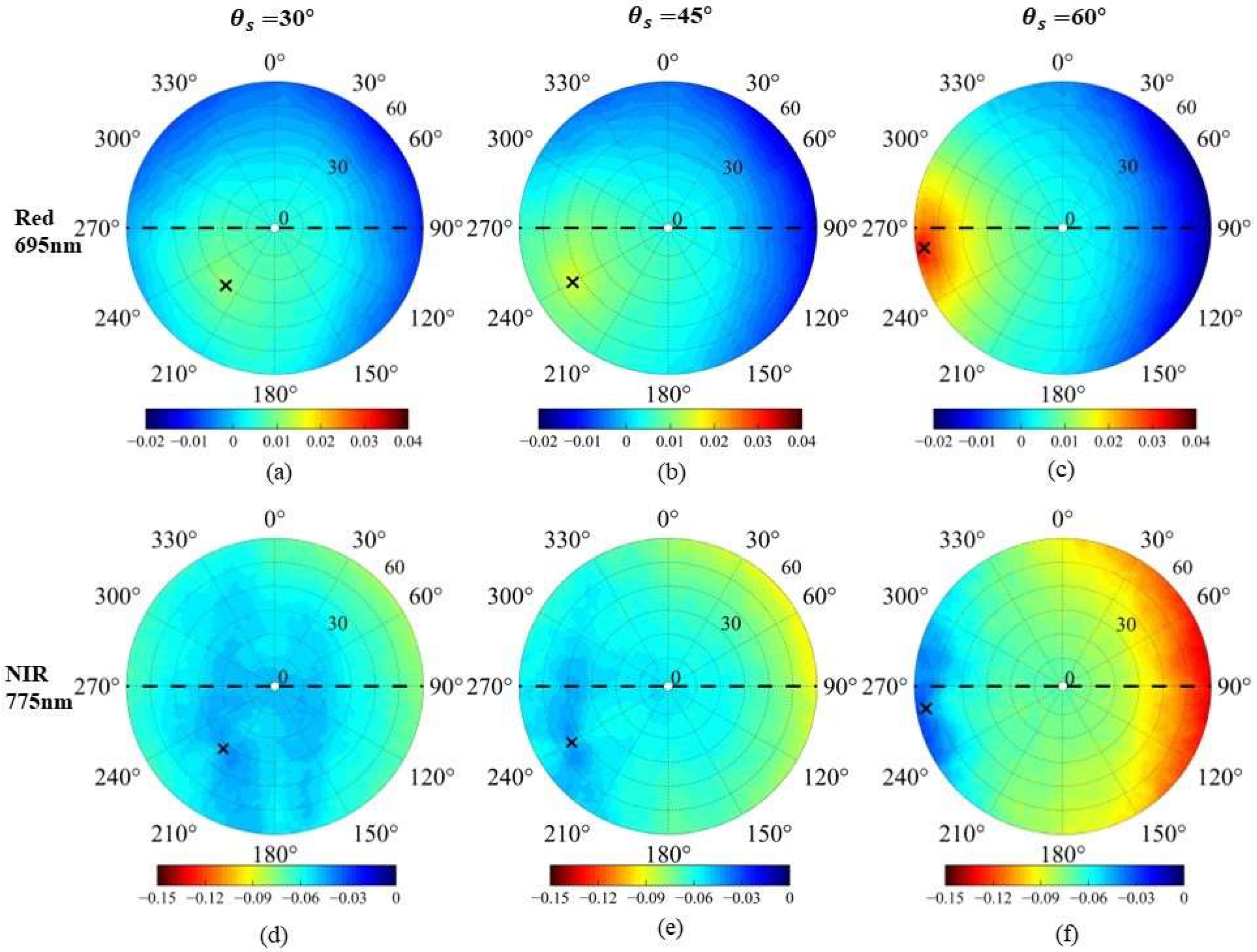
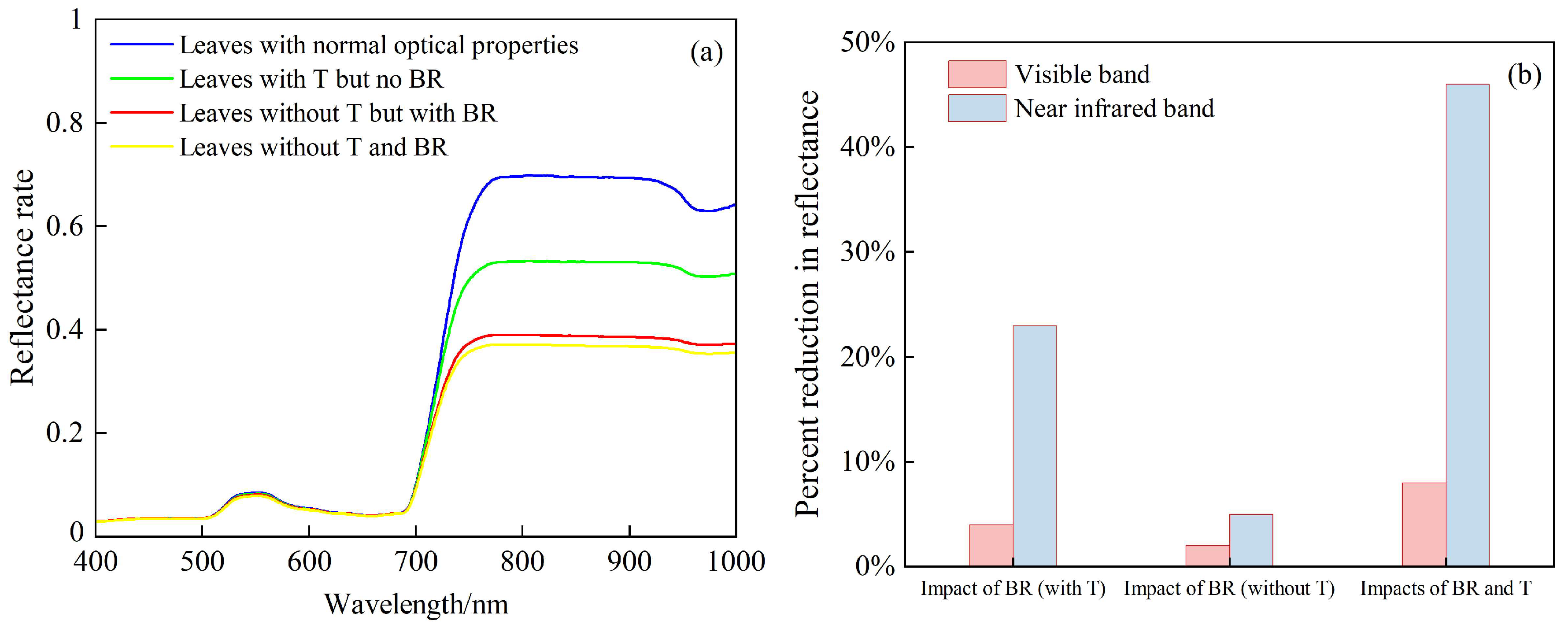
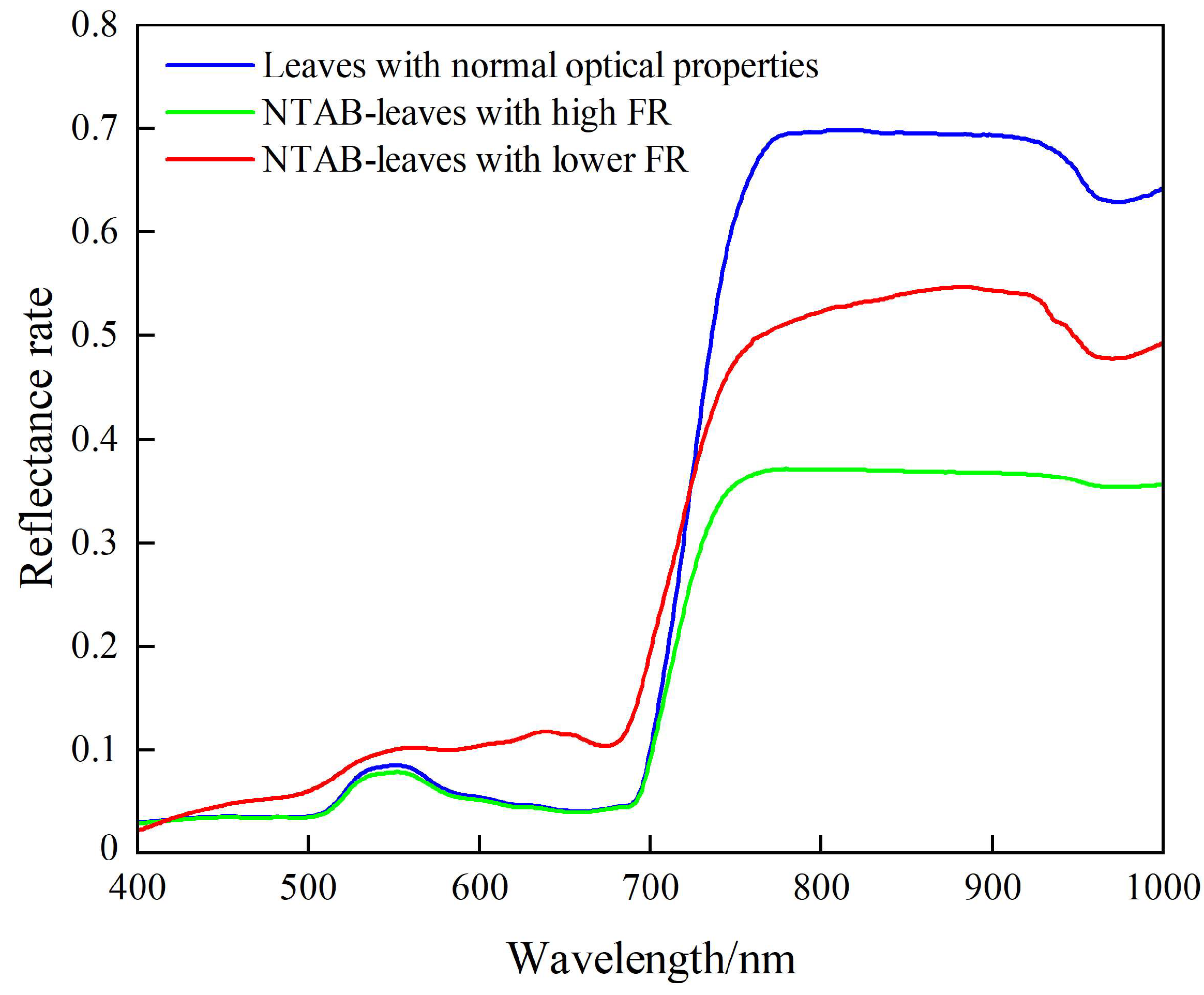
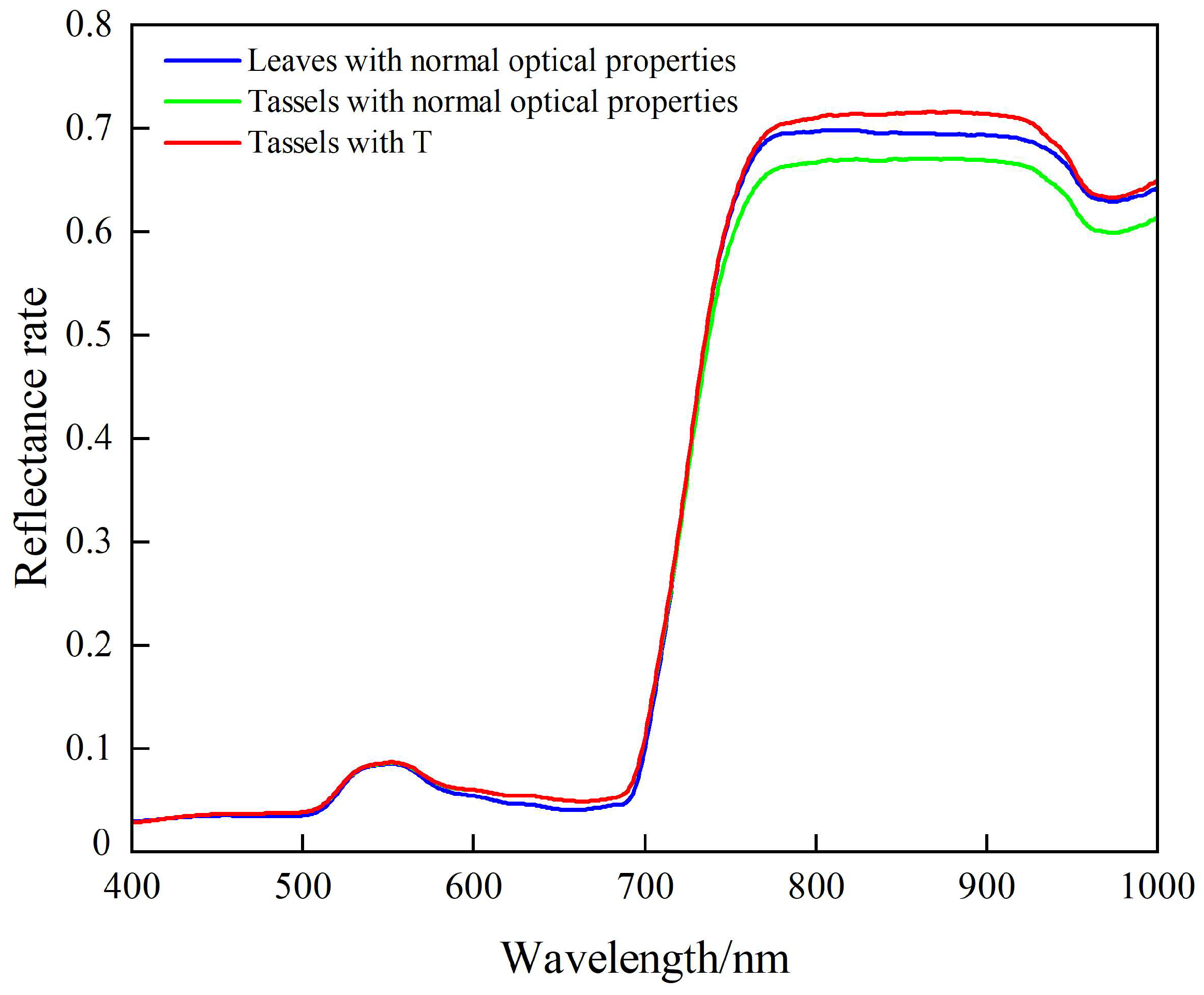
| Parameters | Unit | Value | Description |
|---|---|---|---|
| Structure | |||
| 3D stem + leaf | — | — | Scanner scanning acquisition |
| 3D tassel structure | — | Compact; loose; fewer tassel branches | Tassel measurement system |
| Planting density | plants/hm2 | 60,000; 75,000; 90,000; 12,000 | The plot size is 3.6 m × 3 m |
| Leaf area index | m2/m2 | 5; 4.5; 4; 3.5; 3 | |
| Optical property | |||
| Wavelength | nm | 400~1000 | Field spectral measurements |
| Leaf reflectance | — | — | |
| Tassel reflectance | — | Early tassel-green; middle tassel-yellow; | |
| late tassel-gray | |||
| Soil reflectance | — | — | |
| Illumination | |||
| Solar zenith angle | ° | 30; 45; 60 | |
| Solar azimuth angle | ° | 220; 240; 260 | |
| Observation direction | |||
| zenith | ° | 0~60 | |
| azimuth | ° | 0~360 |
Disclaimer/Publisher’s Note: The statements, opinions and data contained in all publications are solely those of the individual author(s) and contributor(s) and not of MDPI and/or the editor(s). MDPI and/or the editor(s) disclaim responsibility for any injury to people or property resulting from any ideas, methods, instructions or products referred to in the content. |
© 2024 by the authors. Licensee MDPI, Basel, Switzerland. This article is an open access article distributed under the terms and conditions of the Creative Commons Attribution (CC BY) license (https://creativecommons.org/licenses/by/4.0/).
Share and Cite
Jiang, Y.; Cheng, Z.; Yang, G.; Zhao, D.; Zhang, C.; Xu, B.; Feng, H.; Feng, Z.; Ren, L.; Zhang, Y.; et al. Fine-Scale Quantification of the Effect of Maize Tassel on Canopy Reflectance with 3D Radiative Transfer Modeling. Remote Sens. 2024, 16, 2721. https://doi.org/10.3390/rs16152721
Jiang Y, Cheng Z, Yang G, Zhao D, Zhang C, Xu B, Feng H, Feng Z, Ren L, Zhang Y, et al. Fine-Scale Quantification of the Effect of Maize Tassel on Canopy Reflectance with 3D Radiative Transfer Modeling. Remote Sensing. 2024; 16(15):2721. https://doi.org/10.3390/rs16152721
Chicago/Turabian StyleJiang, Youyi, Zhida Cheng, Guijun Yang, Dan Zhao, Chengjian Zhang, Bo Xu, Haikuan Feng, Ziheng Feng, Lipeng Ren, Yuan Zhang, and et al. 2024. "Fine-Scale Quantification of the Effect of Maize Tassel on Canopy Reflectance with 3D Radiative Transfer Modeling" Remote Sensing 16, no. 15: 2721. https://doi.org/10.3390/rs16152721
APA StyleJiang, Y., Cheng, Z., Yang, G., Zhao, D., Zhang, C., Xu, B., Feng, H., Feng, Z., Ren, L., Zhang, Y., & Yang, H. (2024). Fine-Scale Quantification of the Effect of Maize Tassel on Canopy Reflectance with 3D Radiative Transfer Modeling. Remote Sensing, 16(15), 2721. https://doi.org/10.3390/rs16152721







